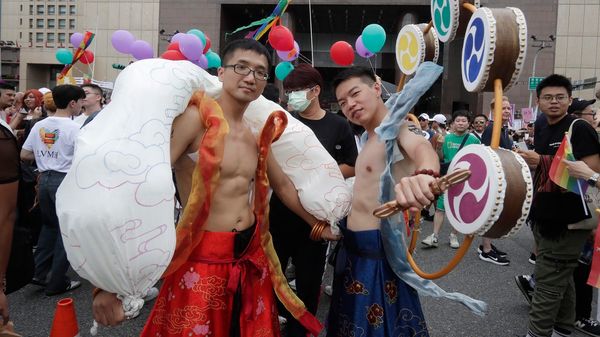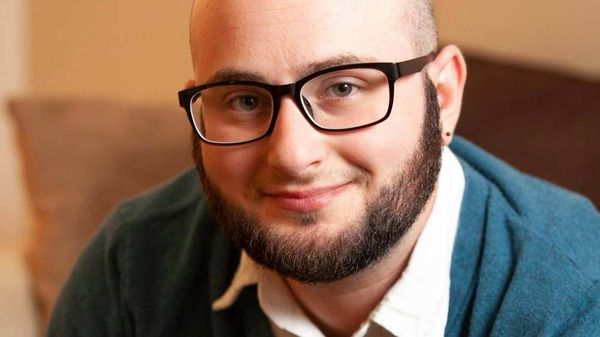February 14, 2008
Advocates talk of past, present state of black community's response to HIV/AIDS
Michael Wood READ TIME: 6 MIN.
Harold Cox, an associate dean in the Boston University School of Public Health and Cambridge's former chief public health officer, launched the lunchtime discussion by asking people in the room to share their own memories of their work at various periods of the epidemic. Many of the people gathered in the room had been involved in founding and working on behalf of some of the organizations that were formed to respond to the epidemic within Boston's black communities, including the Multicultural AIDS Coalition (MAC), Men of Color Against AIDS (MOCAA), and the AIDS program at Dimock Community Health Center.
"I needed to use all the people in this room to tell that story because all of you were involved in it in some way or other," said Cox.
Lonnie McAdoo, associate director of community programs for AIDS Action, talked about the stigma attached to HIV/AIDS in the early '80s.
"I know for me that began the period of time where I seem to recall either going myself or hearing about a lot of people going to funerals of folks in Roxbury, Dorchester, Mattapan, where folks had passed away from cancer, and everybody seemed to very clearly know that it wasn't cancer, but that was what we were all saying, unless we were really definitely behind closed doors," said McAdoo.
Cox said one of the first groups within the black community that began to organize a response to the epidemic in the mid-to-late '80s was people in recovery for substance abuse.
"There were people who were going to recovery groups, and they were saying things like, 'I just found out that I have this thing. Don't know anything about it. Don't know what it is. Tell me what it is that I have and what I'm supposed to do about it,'" said Cox. "And that was actually some of the very beginning of how blacks in this particular community actually started getting engaged around HIV. Yes, there were people who were coming to the AIDS Action Committee, but there were way more people who were going to their recovery groups who were actually talking about the thing they didn't have, and as a result of that there was a fair amount of advocacy that actually started around this."
Cox, who began volunteering with AIDS Action in the mid-'80s as a hotline operator and joined the staff in 1991 as client services director, said during the mid-'80s advocates within AIDS Action formed a Minority Concerns Committee, and members felt that the agency was not appropriately responding to the epidemic within the black community and communities of color. In particular he remembers the committee's dissatisfaction with AIDS Action's work to translate materials into Spanish, and members of the committee felt the translated materials were not translated in language that was culturally appropriate for the populations AIDS Action was trying to reach. As a result of some of those conversations activists worked to form the Multicultural AIDS Coalition (MAC) to do more targeted outreach to those communities.
"The MAC became an important organization to begin to think around advocacy in the African American community. Wayne Wright was the first director. ... He was clearly a man who believed that something should be done," said Cox.
Cynthia Harris, program director at the MAC, talked about the founding of Men of Color Against AIDS (MOCAA), which has since become a program of the MAC. She said in 1988 she became Fenway Community Health's first black employee, and at that time she met Michael Richmond, who was working with Fenway to launch MOCAA. Harris said he frequently butted heads with Fenway's then-executive director, Dale Orlando, in his efforts to get MOCAA off the ground.
"He was passionate about, what about black gay men? We don't want to be labeled. We don't want a lot of the negative stigma that was happening, not to say that it's changed, but he certainly advocated for that group, and people in the community out of that conflict came and rallied around him, because while he started it he had support from Rhoda Johnson Tuckett [of the Boston Public Health Commission's AIDS Program], from Gary Daffin [current executive director of MAC], from lots of key people in the community," said Harris. "He just held onto that dream. So to see that it still lives today is really pretty significant."
Cox said one of the recurring struggles within the HIV/AIDS advocacy movement has been conflict between AIDS Action and communities of color, but he said in some cases that conflict actually produced positive results. He said Dimock Community Health Center launched its AIDS program partly in response to the concern that AIDS Action was not doing effective work within the black community.
"That [conflict] actually is a very important theme that has been throughout the history of AIDS and especially relationships with minority communities. And it's been sometimes disruptive and destructive and sometimes it's actually been the thing that allows us to move to the next step. ... The work that happened at Dimock, some of it grew out of the fact that people did not feel like they were getting the kinds of services they needed to get from this organization, and they did not feel that this organization had the kind of models," said Cox.
Donna Gallagher, a nurse and director of the New England AIDS Education and Training Center, felt that AIDS Action and other service providers had difficulty doing outreach in the black community not because they did not have appropriate models for targeting the community but because the stigma around HIV/AIDS in the black community was greater.
"The AIDS Action group, at least the gay male cohort of patients, would speak out loud, didn't care if I came near them in the community, because once you became the AIDS nurse people would say, 'Don't talk to me if you see me in the supermarket because they'll know what's wrong with me.' But that wasn't the case in the black community. It was very secretive, very much a much bigger stigma. It wasn't so much that the model didn't match, it was the stigma silos were so hardened that people couldn't cross through them all the time," said Gallagher.
Yet that stigma was strong in the white community as well. McAdoo said he was working in the HIV testing program at Dimock in 1991 when Magic Johnson announced that he had HIV, and within the month the department the number of people coming in for tests was six to seven times higher than it had been before the announcement. But most of the people coming in for testing were not part of Dimock's target population.
"But what was really fascinating was that at least 80 percent of those folks were white folks nowhere near our community who wanted to leave their communities to come to Dimock to come get tested so nobody would recognize them or see them," said McAdoo. "We saw very little increase among black folks who lived in the area."
Harris said one of the most pressing issues in dealing with the epidemic in communities of color was the disparity in resources.
"I went from working at the Fenway Community Health Center to communities of color, ... For me it was really eye opening, the disparity, and access to information, even access to condoms," said Harris. "It was amazing because I know that I worked with people in both fields who genuinely cared, so to see that this was going on when people cared so much about the issue, for me it was, wow, what's this about?"
Georgia Simpson-May, deputy director of the MAC, said one of the most recent challenges faced by advocates working on HIV/AIDS issues within the black community is the debate about men on the so-called "down low" or "DL," which refers to men who have sex with men but who do not identify as gay or bisexual and who keep their sex lives with men a secret. The term has been used almost exclusively to talk about black men, and some media reports on the issue have suggested that "DL" men are spreading the virus to their wives or other female partners. Critics of the term, including blogger Keith Boykin, have argued that black men are not the only men who have secret sex lives with other men and that the term unfairly stigmatizes black men. A 2006 CDC fact sheet on the down low says that there has been little research on the impact that so-called "DL" men have on rates of HIV transmission among black women, and many questions about the phenomenon have not been answered.
"One other quick point in recent times is the whole, and for me personally it's a very divisive approach, the whole DL thing, because it is typically associated with black male behavior," said Simpson-May. "And I think right now with us knowing the rates of increase in the African American female population and other non-U.S.-born populations, to have this divide between what's happening in the black male population as being down low, underground, secretive behavior that's driving the epidemic in the black community, it's not a good place for us to work from. I don't like term personally. I don't like it. I don't use it. But at the same time I think as a community, since we are talking about black HIV and AIDS in Boston, that we need to have that conversation about this whole DL notion and how it does a disservice to us."
Michael Wood is a contributor and Editorial Assistant for EDGE Publications.







